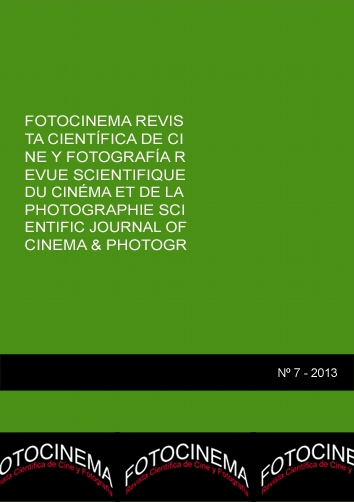Intertextualidad compositiva, representaciones iconográficas en Extremadura
DOI:
https://doi.org/10.24310/Fotocinema.2013.v0i7.5933Abstract
Durante la primera mitad del siglo XX, la fotografía y el cine documental tuvieron un gran peso dentro de los medios de comunicación, acercando con sus imágenes los acontecimientos, tipos, formas, cultura… desde cualquier punto de la tierra. Extremadura se convierte en un inusitado objeto de estudio por parte de diferentes autores nacionales e internacionales, como Ruth Matilda Anderson, Luis Buñuel o W. Eugene Smith, erigiéndose en unas décadas como protagonista de la imagen que España proyecta al exterior. Dichos autores trabajarán en diferentes décadas mostrando en sus obras líneas de intertextualidad compositiva, que vendrán dadas por los elementos iconográficos comunes.
Presentamos un análisis de imágenes, en cuatro grupos de muestra: vivienda; infraestructuras; maternidad e infancia. Para poder realizar un estudio de imágenes que diferente procedencia seguiremos una plantilla de análisis para mostrar las semejanzas morfológicas y compositivas.
During the first half of the twentieth century, photography and documentary film weighed heavily in the media, with their images approaching events, types, shapes, culture… from anywhere on earth. Extremadura becomes an unusual object of study by different national and international authors like Ruth Matilda Anderson, Luis Buñuel or W. Eugene Smith, standing out in a few decades as the protagonist of the image projected outside Spain. These authors work in different decades showing intertextuality works compositional lines, which are given by the common iconographic elements.
We present an image analysis sample into four groups: housing, infrastructure, motherhood and childhood. In order to perform a study of different backgrounds images that follows a template of analysis, which will guide us in showing the morphological and compositional similarities.
Palabras clave: Intertextualidad; Extremadura; imagen; iconográfico.
Key words: Intertextuality; Extremadura; image; iconography.
Downloads
Metrics
Downloads
Published
How to Cite
Issue
Section
License
All contents published in Fotocinema Revista científica de cine y fotografía are protected under the Creative Commons Attribution-NonCommercial-ShareAlike 4.0 International (CC BY-NC-SA 4.0) license. All about this license is available in the following link: <http://creativecommons.org/licenses/by-nc-sa/4.0>
Users can copy, use, redistribute, share and exhibit publicly as long as:
- The original source and authorship of the material are cited (Journal, Publisher and URL of the work).
- It is not used for comercial purposes.
- The existence of the license and its especifications are mentioned.
There are two sets of authors’ rights: moral and property rights. Moral rights are perpetual prerogatives, unrenounceable, not-transferable, unalienable, imprescriptible and inembargable. According to authors’ rights legislation, Fotocinema. Revista científica de cine y fotografía recognizes and respects authors moral rights, as well as the ownership of property rights, which will be transferred to University of Malaga in open access. The property rights are referred to the benefits that are gained by the use or the dissemination of works. Fotocinema. Revista científica de cine y fotografía is published in an open access form and it is exclusively licenced by any means for doing or authorising distribution, dissemination, reproduction, , adaptation, translation or arrangement of works.
Authors are responsable for obtaining the necessary permission to use copyrighted images.













13.png)




